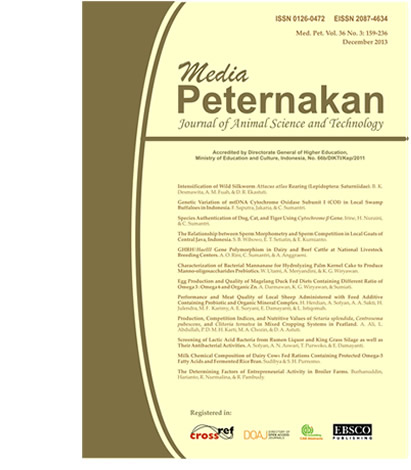Screening of Lactic Acid Bacteria from Rumen Liquor and King Grass Silage as well as Their Antibacterial Activities
Abstract
Probiotic is a live microbial culture which has positive effect on animal by improving the natural balance of microflora in the digestive tract. This experiment aimed to screen and identify indigenous lactic acid bacteria (LAB) from rumen liquor and king grass (Pennisetum hybrid) silage as a probiotic candidate and to evaluate their resistance in low pH, and inhibitory activities against pathogenic bacteria. The LAB isolate was characterized by a clear zone formed on MRSA medium + CaCO3 0.2% (w/v) and further identified by morphological and biochemical assays. The selected isolates were evaluated for their viability in low pH, pathogenic bacterial inhibition, and lactic acid production. The experimental arrangement was a factorial block design (4 x 2) consisted of four isolates and two levels of pH value (pH 2 and 3), each treatment in 3 equal replicates. The result showed that four isolates (two isolates from the rumen liquor of fistulated cattle and two isolates from silage) were identified as lactic acid bacteria. The four isolates showed inhibition activity against Escherichia coli, Bacillus subtilis, Staphylococcus aureus and performed viability at low pH during 2 h treatment. The highest lactic acid production was obtained from isolates Sil.3 (21.42%) and followed by CR2 (19.88%), CR1 (15.40%) and Sil.9 (15.08%). Biochemical identification by standard of analytical profile index (API) 50 CHL kit showed that the selected isolates CR1 was Lactobacillus paracasei ssp. paracasei 3 (91.5%), L. paracasei ssp. paracasei 3 (76.5%), Sil.3 was Lactobacillus brevis (95.1%), and Sil.9 was Lactobacillus collinoides (92.5%). In conclusion, probiotic candidates isolated from rumen liquor are confirmed as L. paracasei ssp. paracasei (CR1 and CR2), while two other isolates from king grass silage are identified as L. brevis (Sil.3) and L. collinoides (Sil.9). L. brevis (Sil.3) and L. paracasei ssp. paracasei (CR1) has higher inhibition against pathogenic bacteria (E. coli, S. aureus, and B. subtilis) than L. paracasei ssp. paracasei (CR2) and L. collinoides (Sil.9).



